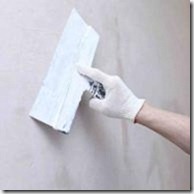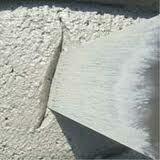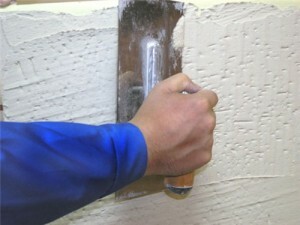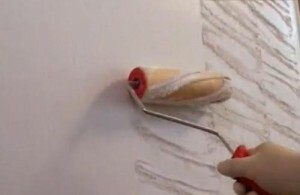Lime plaster: Food Technology and application
Table of contents
- 1 Preparation of lime weight
-
2 Varieties of lime plaster
- 2.1 Lime-plaster
- 2.2 Lime-clay plaster
- 2.3 Lime-cement plaster
-
3 The technology of applying lime-cement plaster
- 3.1 obryzg
- 3.2 Priming
- 3.3 Finishing layer peretirka
- 4 Output
Traditional material for the interior decoration of apartments is still the lime plaster.
Lime mass is prepared directly at the site of plastering or buy ready-made dry blends, which are diluted with water in a certain ratio.
 Benefits:
Benefits:- good insulation and fire-resistant properties;
- environmental friendliness;
- the ability to "breathe";
- flexibility and ease of operation;
- It does not crack while hammering nails into it, and well-kept nails;
- high alkalinity prevents mold and mildew;
- wooden walls would undermine not insects and rodents.
Preparation of lime weight
Mortar is a mixture of slaked lime and river sand in a ratio of 1: 2, 1: 3, 1: 4 or 1: 5. The volume of sand depends on the fat content of lime. If after mixing the solution adheres strongly to the oar, it is necessary to add sand to reduce the fat content; if the mass is not retained on the surface, it is necessary to increase the amount of lime.
Instructions for preparing their own hands:
1. Lime paste is prepared by slaking lime, quicklime.
For this:
- a container (not plastic) pour dry lime;
- lime pour warm water, completely covering lumps;
- container cover heavy lid to react with the lime no poured water;
- after the termination of the "boiling" process of white liquid, strain through cheesecloth, and the remaining lime paste, leave for a day to thicken.
2. Sand sift through a sieve of 3x3 mm or 5x5 mm.
- The container of lime paste, add a little water and sand, in order to facilitate the mixing of the composition. After mixing you should get a homogeneous mass without lumps.
3. Pour small portions remaining sand while adding water.
4. Finished weight should have a normal fat content and consistency with medium viscosity.
The solution was grasped for plaster slowly, so it can be used for 2-2.5 days after preparation.
Varieties of lime plaster

Ready lime-plaster solution (price - from 390 rubles).
Lime well coexists with binders such as gypsum, cement and clay. This made it possible to obtain other types of lime-based plasters which have improved properties.
Lime-plaster
It has greater strength and rapid curing process in comparison with the simple plastering.
Almost never used for plastering the walls outside buildings. More common as the interior decoration with normal humidity. Gypsum is a much faster process works as grasped already after 3-5 minutes and is fully cured after half an hour.
For this reason, it is not recommended to mix large amounts of a mixture (up to 5 l) and run with masses containing gypsum, novice masters.
Preparation:
The proportions of ingredients: 1 part of plaster and 3-4 parts of lime weight.
- Knead simple mortar.
- Remove the container from about 3 liters mass.
- In place of pour gypsum formed, pour the water and mix.
- Return previously deleted weight and the whole was mixed thoroughly but not more than 3 min. If necessary, add water.
- Use weight for 6 min.
Important! Grout applied easily grasped because it is slower, but its strength will be lower.
Lime-clay plaster
It is made from a solution consisting of clay and lime paste in a ratio of 1: 0.5 and 3-6 parts sand.
Clay dough is prepared analogously to lime. Quarry clay or clay powder shut water. After several days the mixture was poured through a screen to obtain a plastic dough-like material.
Preparation:
- The tank mix binders - lime and clay dough.
- Gradually add the mixture of sand and water, thoroughly mash paddle.
- If clay fat (mass adheres strongly to the oar), increase the number of sand. If the clay is thin (the solution does not stick to the oar), reduce the amount of sand.
An advantage of the clay mass is their low cost and environmental friendliness.
Because of the low strength wall plastering clay pure almost never used.
To increase the strength before it is added straw, sawdust, shavings. Now composition include astringent ingredients - lime, cement and plaster.
Lime-cement plaster
It is used for interior decoration of high humidity premises, as well as a base for stacking their hands decorative plaster, ceramic tiles. It gives strength cement, lime - plasticity.
The proportions of components: 1 part cement and 2-5 parts of building sand, 1 part lime putty.
Preparation:
- Prepare a mixture of dry components - cement and sand.
- Filtered slaked lime bring to a state of milk of lime (mix with water in equal amounts) and pour into a container with the dry mix.
- Mix thoroughly and add water, bring to desired consistency.
The technology of applying lime-cement plaster
Plastering of walls:
- obryzg;
- primer (base layer);
- peretirka finishing layer.
All layers of plaster are required to obtain a high-quality and durable finish.

The photo application of lime-cement plaster
obryzg
It serves to improve the adhesion of the layer applied to the base prepared for plaster walls. To prepare the slurry taking 1 part of Portland cement (M400, M500), 0.2 part and 2.5 part lime sand. Sprinkles the surface using a trowel with a thin layer and not aligned.
Priming
It is the main layer has a thickness of up to 5 cm. Mass made thicker for him to take the preparation 1 part cement, lime and 0.2-0.3 parts 2 parts sand. The solution may be run at a wall or trowel applied spreader. Surplus removed with a plaster cutter (rules). Control of flatness of plaster is checked vertically and horizontally.
Finishing layer peretirka
It aims to remove small chips, atone plastered surface until a smooth texture. The consistency of the mass is close to the rendering. Mixing ratio: 1 part cement, 0.2-0.3 parts of lime, 1-1.5 parts sand. Apply a layer of a few millimeters and is ground in a special surface float.
Output
Before you prepare a solution for plaster, it is important to choose the desired consistency and the type of binder. Internal plaster of concrete and brick surfaces can be made of lime, lime-gypsum, lime, clay, of lime-cement mortar, wood surface better than the lime-gypsum plaster, gypsum or clay-clay-cement composition.
We hope that our material has been useful for you. We can only wish you good luck and offer to view the video in this article.


